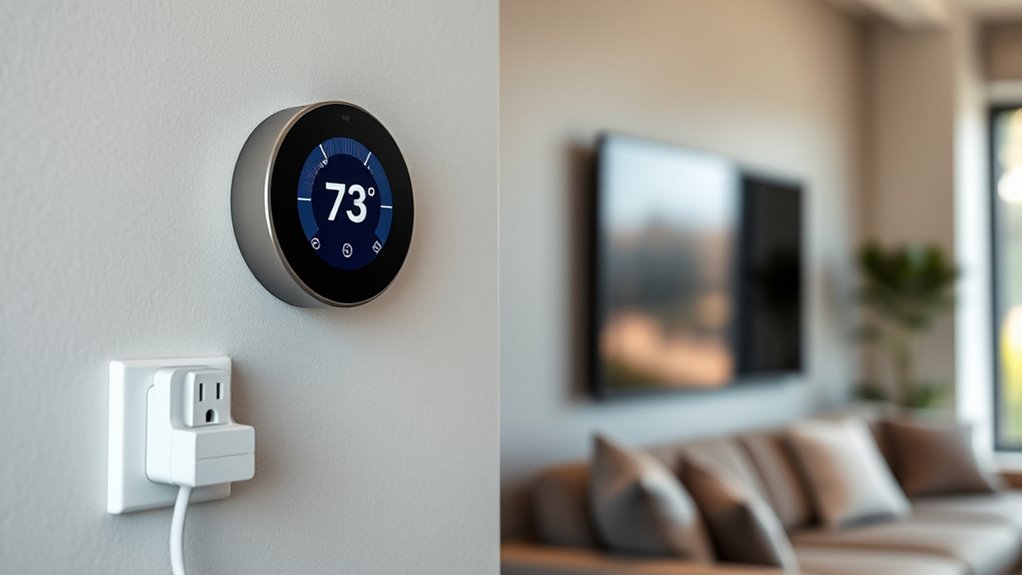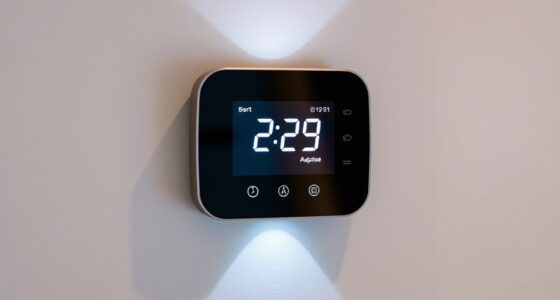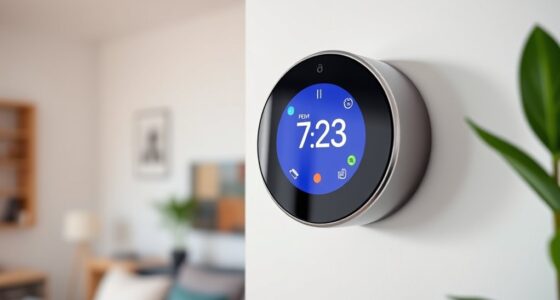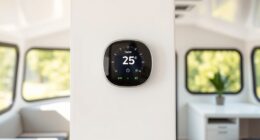When choosing between hardwired and plug-in smart thermostats, consider your home’s wiring and HVAC system. Hardwired models offer a seamless look and better integration but may need professional setup and a C-wire. Plug-in thermostats are easy to install, portable, and suitable if wiring is limited, but they rely on batteries or power adapters. Understanding your system’s needs and your installation preferences will help you make the right choice as you explore further options.
Key Takeaways
- Hardwired thermostats offer seamless integration with existing HVAC systems but may require professional installation and wiring upgrades.
- Plug-in thermostats are easy to install, portable, and ideal for DIY setups without extensive wiring.
- Compatibility with your HVAC system and Wi-Fi network is crucial when choosing between the two options.
- Hardwired models provide a cleaner aesthetic but depend on features like a C-wire or alternative power solutions.
- Plug-in thermostats are flexible for different rooms but may have limitations with advanced system features.

When upgrading your home’s heating and cooling system, choosing the right smart thermostat can make a significant difference. One of the first decisions you’ll face is whether to go with a hardwired model or a plug-in version. Your choice will impact installation requirements, compatibility considerations, and overall ease of use. Hardwired thermostats typically connect directly to your home’s wiring, often providing a more seamless integration with your HVAC system. They usually require a C-wire, or common wire, which supplies continuous power to the device. If your current setup doesn’t include a C-wire, you might need to run additional wiring or opt for a model that supports power-sharing or power-stealing technology. Compatibility considerations are key here—before purchasing, you should verify whether your existing wiring and HVAC system support a hardwired thermostat. Some older systems may lack the necessary wiring, making installation more complicated or requiring a professional upgrade.
Hardwired thermostats require compatible wiring and may need professional installation.
In contrast, plug-in smart thermostats are designed to be easily installed without extensive wiring work. They typically come with a power adapter or use batteries, making them an attractive option if you’re not comfortable with electrical work or if your system lacks a C-wire. However, it’s still important to check compatibility considerations, especially with regard to your Wi-Fi network and HVAC control setup. These models usually connect via a standard outlet and can be moved between rooms, giving you flexibility. That said, some plug-in options may have limitations in terms of integration with certain HVAC systems or advanced features, so reviewing the product specifications beforehand is essential.
Ease of installation is another factor to consider. Hardwired thermostats might require professional installation, especially if new wiring is necessary, but they tend to provide a cleaner, more integrated look. Plug-in thermostats, meanwhile, are straightforward to install yourself—simply plug them into an outlet, connect to your Wi-Fi, and follow the setup instructions. While this convenience appeals to many, it’s still wise to confirm that your Wi-Fi signal is strong enough to support a smart device, and that the thermostat’s features align with your comfort and scheduling needs.
Ultimately, your decision hinges on your existing wiring, comfort with electrical work, and the level of integration you want. Carefully evaluate installation requirements and compatibility considerations before making your choice. Doing so ensures you pick a smart thermostat that fits seamlessly into your home, providing reliable control and energy savings for years to come.
Frequently Asked Questions
Can I Upgrade My Existing Thermostat to a Smart One?
Yes, you can upgrade your existing thermostat to a smart one. First, check your thermostat compatibility to verify it works with your system. Then, consider wiring considerations; some homes may need additional wiring or a C-wire for power. If you’re comfortable with electrical work, you can install it yourself. Otherwise, it’s best to hire a professional to ensure proper installation and compatibility.
Do Smart Thermostats Require Wi-Fi for All Features?
Think of your smart thermostat like a remote control for your home’s comfort. Yes, many smart thermostats depend on Wi-Fi for full features, like remote control and voice commands. Without Wi-Fi, you can still manually adjust settings, but some smart features won’t work. If your Wi-Fi drops, expect limited control, so a stable connection is key for enjoying all the benefits of your smart thermostat.
Are There Safety Concerns With Hardwired Thermostats?
Hardwired thermostats are generally safe if installed correctly, but electrical safety is vital. You might face installation complexity, especially if you’re not comfortable handling wiring, which could pose risks like short circuits or shocks. Always turn off power before installation, and consider hiring a professional to guarantee proper setup. Proper installation minimizes safety concerns and helps your thermostat function reliably without electrical hazards.
How Long Does Installation Typically Take?
Like a well-orchestrated symphony, your installation timeline depends on your home’s setup. Typically, hardwired thermostats take about 1-3 hours, but complex wiring might extend this. Having a technician assist guarantees a smooth process, saving you time and avoiding mistakes. Expect to be up and running swiftly, with professional help making sure everything’s wired correctly and safely, so you can enjoy your smart home without delay.
Are There Compatibility Issues With Certain HVAC Systems?
You might face compatibility issues depending on your HVAC system and wiring requirements. Some thermostats only work with specific systems like heat pumps or multi-stage units. Before buying, check your system’s compatibility and wiring needs carefully. Hardwired models often need a C-wire, while plug-in types may be more adaptable. Making sure your thermostat matches your HVAC setup prevents installation delays and ensures reliable operation.
Conclusion
Ultimately, your choice depends on your home’s setup and your tech needs. For example, if you have a newer, wired system, a hardwired thermostat offers seamless integration. But if you’re renting or want easy installation, a plug-in model is ideal. Imagine saving energy and money by simply swapping out a plug-in unit—it’s that easy. Consider your situation carefully, and you’ll find the perfect thermostat to keep your home comfortable and efficient.









